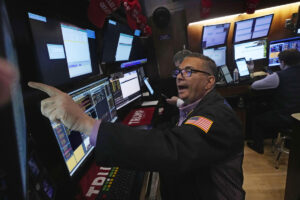Recent Market Trends and Economic Insights
In a turbulent market environment, U.S. stocks took a notable downturn last Friday, reflecting investor anxiety concerning potential new tariffs from the Trump administration. This reaction followed an uptick in consumer inflation expectations and a lukewarm jobs report for January, a combination that put additional pressure on major indices.
The S&P 500 (^GSPC) fell nearly 1%, while the Nasdaq Composite (^IXIC) was hit harder, declining by approximately 1.4%. This marks the second consecutive week of losses for both indices. Meanwhile, the Dow Jones Industrial Average (^DJI) suffered a loss of over 400 points, or nearly 1%, representing its worst daily performance in roughly four weeks.
President Trump announced plans for reciprocal tariffs on American imports during a meeting with Japan’s Prime Minister Shigeru Ishiba. His comments underscored an environment filled with uncertainty and potential trade escalations, further contributing to market volatility.
Consumer Sentiment and Inflation Expectations
This week, U.S. consumer sentiment plummeted to a seven-month low, with the preliminary Michigan Consumer Sentiment Index registering a sharp decline. Inflation expectations saw a drastic increase, rising to 4.3% from the previous month’s 3.3%. These figures represent the highest inflation expectations recorded since November 2023 and highlight the growing unease among consumers about the economy’s direction.
The sentiment drops were compounded by the jobs report, which revealed that only 143,000 jobs were added in January, falling short of economists’ expectations. However, a silver lining for the labor market emerged: unemployment edged down to 4.0% from 4.1% in December. This modest improvement, combined with a rise in hourly wages, suggests resilience within the labor sector, even amid mounting economic concerns.
Sector Performance and Big Tech Update
Sector-wise, the S&P 500 reflected a broad-based sell-off, with Consumer Discretionary, Materials, and Technology being the primary laggards. Big Tech, particularly, faced headwinds, with Amazon (AMZN) shares tumbling about 4% following disappointing revenue forecasts.
Tesla (TSLA) also experienced volatility this week due to disappointing delivery figures in China, with an anticipated drop of nearly 11.5% in sales year-over-year. Share prices of the electric vehicle leader plummeted nearly 9% during the week, showcasing the heightened competition from local rivals like BYD, which reported a staggering annual sales increase of 47%.
Looking Ahead: Trends in Monetary Policy and Market Outlook
On a broader economic front, Chicago Federal Reserve President Austan Goolsbee indicated that while the Fed might be on hold regarding interest rate hikes, he anticipates that rates could trend lower within the next 12 to 18 months. His comments came in response to solid job growth data, underlining a narrative that may temper aggressive monetary policy in the near future.
As inflation fears continue to mount, investors are urged to stay vigilant. The sentiment shift suggests a paradigm shift in consumer behavior regarding spending and saving. With mortgage rates hovering around 7%, homebuyers may need to recalibrate their expectations, as Fannie Mae’s latest survey shows a growing number of consumers now believe high rates could persist.
Conclusion
As stock markets brace for further developments surrounding tariffs, inflation expectations, and economic policies, investors should monitor these trends closely. The intricate interplay of these factors will continue to shape market dynamics and potentially open new avenues for investment strategies. Always remember – understanding the context of these fluctuations can empower you to make informed decisions in an ever-evolving financial landscape.

